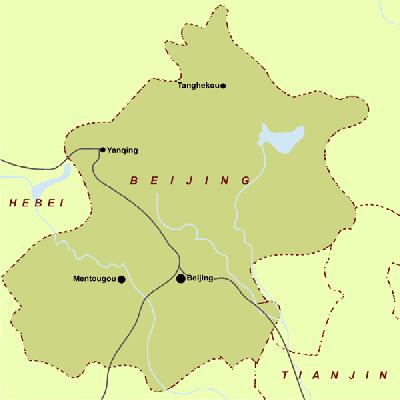| Map |
|
|
Beijing
Beijing has a continental monsoon climate commonly found in the temperate zone. In winter, cold, dry winds blow out of Siberia and Mongolia in the northwest; in summer, warm, moist air currents from the southeast take over. It has an annual average temperature of 11.5oC. The coldest month in Beijing is January, with an average temperature of -9 to -4oC; the hottest month is July, with an average of 25oC. The average annual rainfall is 609 millimeters.
Beijing is divided into 14 districts and 4 counties, with a population of 13.82 million, mainly with Han, Hui, Manchu and Mongolian ethnic groups.
Official city trees: the Chinese scholar tree and oriental cypress
The stately cypress symbolizes the courage and strength of the Chinese people, their simple, and hard working nature and their defiance in the face of aggression. The scholar tree is a symbol of good fortune, joy and well-being.
Official city flowers: China rose and chrysanthemum
The rose, a Chinese native, has been cross¡¡bred many times, but it still has half of the original Chinese traits. Known as Perpetual Spring, Monthly Red, Snow Challenger and Victorious, it grows quickly, regenerates easily and is graceful and long blooming (May to October).
The chrysanthemum has many names and varieties. In Beijing potted chrysanthemums may be seen year round. They flower in summer and fall naturally but can be forced to bloom any time of year.
Dishes with special flavor such as the Peking roast duck, imperial court food, imperial official food and medicinal food, hot pot; traditional snacks such as sausage, quick-fried tripe, soya-bean milk, jellied bean curd, seasoned flour mush, jimmy meat and fried pasty, etc.
Beijing is the one of the birthplaces of Chinese Civilization and one of the six ancient capital cities in China. During the last 3,000 years it served as a capital for several dynasties. Since the discovery of a complete skull of Peking man living approximately 200,000 to 500,000 years ago in Zhoukoudian, situated 50 kilometers to the southwest of Beijing proper, Zhoukoudian became world-famous as the home of the Chinese ape-man.
Beijing, a municipality directly under the Central Government, is the capital of the People's Republic of China and the country's political, economic, cultural and transportation center as well as a famous historic city. Beijing is the second largest city in China.
Beijing is the political center of China where the Party's Central Committee, the State Council, ministries and commissions under the government, and more than 140 foreign embassies are located. It is also an international exchange center.
Being one of the biggest industrial bases in China, Beijing's industrial production is the second largest in value among all Chinese cities. An industrial system with iron and steel, coal, machinery, chemical and petroleum, textiles, electronics and other industries as its mainstays has already taken shape. Beijing's arts and crafts are famous for their long history, great variety, and superb workmanship. The most popular ones among them are cloisonne, ivory carving, jade ware, carved lacquer ware, snuff bottles, silk flowers and Beijing's embroidery etc.
As the country's center of culture, education, science and technology, Beijing has more than forty state scientific research institutions, over thirty universities and various exhibition halls, museums, cinemas and palestras. The National Library of China is the largest library in Asia.
It is a hub of communications, with good railroad and air links with all parts of China, as well as with major international cities, thus facilitating the rapid development of tourism as an important industry in Beijing.
Beijing is an ancient city with a long cultural history. The four feudal dynasties -- Jin, Yuan, Ming, and Qing had all set up their capital here. That's why it became a most concentrated place of the country's scenic spots and historical sites, with 23 State-protected Sites of Cultural Relics. Among them, the best known are the Forbidden City, the Summer Palace, the Great Wall, the Temple of Heaven, Zhoukoudian Site, and the Ming Tombs, etc. Beijing's Hutong (narrow bystreets) and Siheyuan (quadrangle) are quite worth a visit. |
||||
 |
 Geography
Geography
 Climate
Climate Administrative Division and
Population
Administrative Division and
Population Official Trees and Flowers
Official Trees and Flowers Food
Food Brief Introduction
Brief Introduction